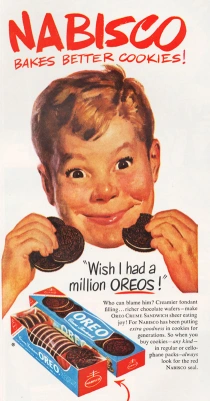“Want to build a wall around Manhattan?” asks this 1948 ad for Goodyear. Well in 2016 one has already been built.
Billionaire Donald Trump’s pipe dream of wanting to build a wall along the Mexican Border of the U.S. may never happen, but the wealthy 1% have already constructed a virtual wall around Manhattan effectively keeping out the undesirables…the middle class.
The city increasingly feels like a gated community for the well off and their families.
Who’s City is it Anyway?
No where is the widening wealth gap more evident than in our urban areas and in large cities across the country from San Francisco to Boston the middle class is disappearing.
The ad copy asks the hypothetical the question “How many bricks do you think it would take to build a solid wall 36 feet high and 40 inches thick all around the island of Manhattan?”
Of course there is no need to actually use the 405,000,000 bricks it would take to build the 36 foot high wall, 40 inches thick around the 30 mile perimeter of Manhattan island. Astronomical prices have forced middle class out of not just N.Y. but major cities from coast to coast.
Along with Mom and Pop shops, middle class Mom and Pops themselves are getting the boot as NYC’s once thriving middle class is headed for extinction.
If this continues, the urban middle class will be destined to become just another urban myth.













Urban middle class – was it that was featured in the Fred Astaire – Ginger Rogers movies? No sign of any work for a living, dining out in tuxedo – or was it “tails”?
Now, with gentrifying and penthouses and all – is the thing coming back?
LikeLike
Hello. By now, after the 2001 terror attacks, Manhattan is basically a commodity & terror trap! Go ahead Manhattan, build your wall so you can’t escape!
Thanks for the moderation. 🙂
LikeLike
The sad thing is that it is becoming less and less affordable to live in the United States.
LikeLiked by 2 people
You are quite right….its heartbreaking
LikeLiked by 1 person
Our brain misleads us – we are more afraid of unusual causes of death than the usual. And deliberate killings scare more than those caused by carelessness But a death is a death, and if you die, you die. And after that, it doesn’t matter how you died.
“The table below is a list of motor vehicle deaths in the United States by year. On average in 2012, 92 people were killed on the roadways of the U.S. each day, in 30,800 fatal crashes during the year.”
United States military casualties of war
Rank War Years Deaths Deaths per Day US Population in First Year of War Deaths per Population
1 Am Civil War 1861–65 750,000 420 31,443,000 2.385% (1860)
2 World War II 1941–45 405,399 297 133,402,000 0.307% (1940)
3 World War I 1917–18 116,516 279 103,268,000 0.110% (1920)
4 Vietnam War 1961–75 58,209 11 179,323,175 (1960) 0.030% (1970)
5 Korean War 1950–53 54,246 45 151,325,000 0.020% (1950)
6 Am Rev War 1775–83 25,000 11 2,500,000 0.899% (1780)
LikeLike
Costs of living – I’ve tried my old school math, converting Swedish gasoline prices in SEK per liter to USD per gallon. I got around $ 6.07 (13.22 SEK per liter)
(I’ve bought a bicycle in very good used condition with 24 gears,)
How much have two parents with two kids have to pay in insurance costs to get everything covered, so they don’t have to sell the house if one of them get a cancer?
LikeLike
Vintage ads, Swedish style
LikeLike
…says Nobel Prize Winner in Economics Joseph Stiglitz. I’ve read his exceptional book “The Price of Inequality: How Today’s Divided Society Endangers Our Future” TWICE. An easy read for any American voting citizen who wants to TRULY understand our nation’s economics and where they’ve been headed since 1946. Stiglitz is also Professor of Economics at Columbia University. He goes on…
The brilliant economist goes on to layout a 37-point prescription for America’s economic dysfunction, click here: Rewriting the Rules of the American Economy. Again, an excellent recovery plan and quite doable in time!
Wonderful post Sally, as usual Ma’am. 😉 ❤
LikeLiked by 1 person
Thank you bringing up that important book. I too have read it and it is a must read.
LikeLiked by 1 person
You have read it, huh? Well, don’t you just continually impress Madame! 😉
LikeLiked by 1 person
I am a voracious reader, especially of non fiction
LikeLike